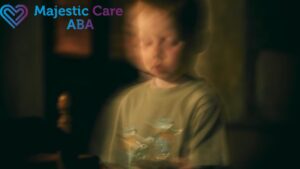The way we see shapes is how we connect with the world. For many autistic people, vision works a little differently. Colors might pop too bright, patterns may seem overwhelming, or light could feel sharp and distracting. These differences are often described as visual sensory issues autism, and they play a big role in how daily life feels.
Research suggests that most individuals on the autism spectrum experience some kind of sensory difference, with vision being one of the most common (Robertson & Baron-Cohen, 2017). But what does that mean day to day? Imagine the world as a puzzle with missing pieces—or sometimes extra ones. It can be confusing, but it can also lead to strengths, such as noticing tiny details or excelling in creative visual work.
So, let’s break this down together. We’ll explore what science knows, look at real-life signs, and share practical strategies to make visual experiences calmer, clearer, and more supportive.
What Are Visual Sensory Issues in Autism?

Visual sensory issues are not about eyesight itself. They’re about how the brain processes what the eyes see. For autistic individuals, that processing may be too strong, too weak, or simply different from what’s typical.
A 2020 review in the Journal of the Korean Academy of Child and Adolescent Psychiatry found differences in the way autistic brains handle early visual information. In plain words, even the first step of “seeing” feels different. This affects everything from recognizing faces to walking through busy places.
Key points to keep in mind:
- Glasses don’t solve it—it’s not about eye strength.
- It’s about how the brain filters and organizes what the eyes take in.
- Challenges often come with strengths, like noticing fine details.
Examples of Visual Sensory Issues Autism Can Present
Each person’s experience is unique, but research has mapped common patterns:
- Light sensitivity (photophobia): Bright or fluorescent lights feel harsh and distracting.
- Motion sensitivity: Fast visuals like fans or scrolling screens can overwhelm.
- Pattern sensitivity: Grids, stripes, or repeated shapes may trigger discomfort.
- Color sensitivity: Certain shades feel “too much” or cause strong reactions.
- Difficulty with eye contact: Not always about shyness—it can feel visually overwhelming.
- Peripheral vision focus: Looking from the side may feel easier than looking straight on.
A study from the University of Manchester (Parmar et al., 2021) found that autistic adults reported motion, patterns, and colors as top sources of discomfort. Yet, many created their own coping methods—like wearing sunglasses indoors or focusing on calming shapes.
Why Vision Plays Such a Big Role in Autism
Think about how often you rely on sight—reading, walking, or recognizing a friend’s face. When those processes feel different, the impact spreads across life.
- Motor skills: Trouble judging depth may make running or catching harder.
- Learning: Tracking words on a page can slow down reading.
- Social skills: Missing facial cues affects conversations.
In fact, Jones et al. (2009) showed that autistic children often focus more on objects than faces. That shift in attention influences how social signals are understood.
Real-Life Signs of Visual Sensory Differences

So, how do these challenges look in everyday life? Parents, educators, and individuals often notice:
- Staring at spinning objects or lights.
- Tilting the head or looking sideways.
- Rubbing or covering the eyes.
- Avoiding busy places like malls.
- Squinting in bright sunlight.
- Zeroing in on small details, like wheels instead of whole toys.
These aren’t random quirks. They’re meaningful ways of making sense of a world that can feel visually intense.
Table: Common Visual Behaviors in Autism
| Behavior | Possible Meaning | Example Situation |
| Side glancing | Direct focus feels too strong | Looking at toys sideways |
| Staring at lights | Comfort or self-regulation | Watching ceiling fan blades |
| Avoiding eye contact | Too much visual intensity | Looking away in conversation |
| Squinting or rubbing | Light sensitivity | Covering eyes under bulbs |
| Focusing on patterns | Detail preference | Tracing lines on wallpaper |
The Science Behind Visual Processing in Autism
So, why does the brain handle sight differently?
- Brain imaging shows differences in the primary visual cortex, the area that first processes vision.
- Research suggests autistic people often rely more on the ventral stream (detail processing) than the dorsal stream (motion and spatial awareness).
This helps explain why some excel at spotting tiny details but struggle with “big picture” vision. For some, this becomes a strength in art, design, or engineering.
Positive Outcomes Linked to Visual Differences
While many studies focus on challenges, it’s just as important to highlight strengths. Visual differences can create unique talents:
- Detail recognition: Spotting small differences others miss.
- Artistic ability: Many autistic artists excel in drawing or digital design thanks to strong visual memory.
- Problem-solving: Detecting patterns can support success in math or coding.
Temple Grandin, a scientist and autistic advocate, has often said she “thinks in pictures.” That visual-first perspective helped her redesign livestock handling systems used worldwide.
Coping Strategies That Work
What helps when vision feels overwhelming? Research and personal stories point to small but powerful changes:
- Wearing tinted lenses or sunglasses indoors.
- Choosing seats away from bright windows or bulbs.
- Keeping classroom walls simple and clutter-free.
- Allowing visual breaks—pausing to close eyes or look at calming images.
- Using visual schedules with clear pictures.
A 2018 study by Little suggested that tinted lenses and vision therapy reduced eye strain and boosted focus in children with autism. Sometimes, even small changes—like softer lighting—make daily life easier.
How Families and Educators Can Support Positive Vision Experiences
Support doesn’t need to be complicated. A few thoughtful changes can transform learning and home environments:
- Use natural lighting whenever possible.
- Break down tasks into simple visual steps.
- Limit bold patterns in classrooms.
- Create calm corners with dimmer light.
These adjustments lower stress, boost focus, and create inclusive spaces.
Visual Sensory Issues Autism: Looking Ahead
Some studies suggest that unusual visual patterns appear even before a formal autism diagnosis (Chung & Son, 2020). Spotting early signs—like staring at lights or avoiding faces—may help families seek support sooner.
Future research continues to explore where in the brain these differences begin. Yet, the voices of autistic adults remind us that science only tells part of the story. Daily lived experience shows what it actually feels like and how strategies can make life better.
FAQs
1. Can visual sensory issues improve over time?
Yes, many autistic people notice changes as they grow. Strategies such as tinted lenses or structured environments help the brain adapt.
2. Do all autistic people experience visual sensory challenges?
Not everyone. About 70–90% have some sensory difference, but intensity and form vary.
3. Are visual sensory issues linked to intelligence?
No. They reflect processing differences, not intelligence. In fact, some turn them into strengths in creative or technical work.
4. Why do some autistic people look more at objects than faces?
Objects are often easier to process than rapidly changing human expressions.
5. What classroom change helps the most?
Steady, soft lighting and clutter-free walls usually reduce visual stress. Many also benefit from clear visual schedules.
Seeing the World Through Unique Lenses

Vision guides how we move, learn, and connect. For autistic individuals, visual sensory issues from autism bring both challenges and strengths. At Majestic Care ABA, we believe these differences call for understanding, not limits.
From light sensitivity to remarkable detail recognition, each person’s way of seeing is unique. Science continues to uncover the “why,” but lived experiences already show us what works: small changes, practical support, and celebrating visual strengths.
Families across Indiana and beyond are learning that with the right strategies, daily life can feel calmer and more connected. That’s the heart of our work at Majestic Care ABA. We’re here to walk alongside families, share practical solutions, and provide tailored support.
If you’re ready to see how personalized ABA services can help your child thrive, reach out to us today. Together, we can unlock not only comfort but also creativity, confidence, and connection.


